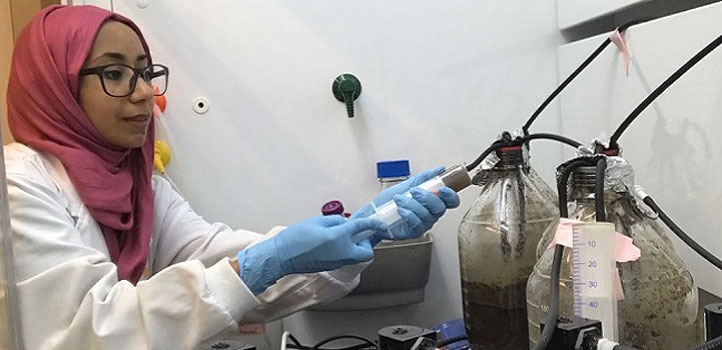Environmental Science and Engineering
Sunny solution for killing E. coli
Treating wastewater with solar irradiation shows promise in reducing two E. coli strains but a resilient strain persists.


Nada Al-Jassim and coworkers conducted experiments to verify whether solar irradiation can be used to kill E.coli strains in wastewater.
© 2017 KAUST
Increasingly virulent strains of Escherichia coli are circulating in wastewater around the world, and the race is on to find novel treatment processes that could help reduce the spread of these pathogens. KAUST researchers examined how three strains of E. coli found in Jeddah’s wastewater supply fared when placed under strong sunlight: they showed, while two strains were reduced, one strain persisted.
“Solar irradiation is used unintentionally in many places when treated wastewater is stored in an evaporation pond prior to reuse or when it is used to irrigate crops in daylight,” says Pei-Ying Hong, who led the project with PhD student Nada Al-Jassim and coworkers at KAUST’s Water Desalination and Reuse Center. “However, because this approach is unintentional, it is difficult to know how successful it has been. We therefore decided to analyze what happens to E. coli in wastewater under solar irradiation.”
Sunlight is known to kill pathogens in freshwater. In fact, as Hong notes, nongovernment organizations recommend that rural communities with no treatment for basic drinking water should store their water in transparent plastic bottles, and that they place these bottles in direct sunlight for some hours before consumption.
Hong’s team used a similar idea; they prepared two reactors each carrying a strain of E. coli—a recently discovered, highly antibiotic-resistant strain called PI-7, and a common, nonvirulent strain called DSM1103. These reactors were subjected to solar irradiation for 24 hours, while two identical reactors were stored in the dark as controls. The team took samples at regular intervals from the four reactors and analyzed changes to the genetic make-up and the survival rates of each strain of E. coli.
“The viable cell counts of both strains reduced considerably, but E. coli PI-7 decayed at a slower rate compared to DSM1103,” says Hong. “Rather worryingly, and unlike DSM1103, PI-7 formed ‘persister’ cells in the later stages of prolonged solar exposure. This means a small portion of PI-7 cells can withstand solar treatment and regrow again when the environmental conditions become favorable.”
PI-7 defended itself against solar irradiation by upregulating genes related to cellular repair and oxidative stress, along with various virulence factors. However, during the genetic analysis, Al-Jassim noted with interest that genes carried by PI-7 to protect it from viruses were downregulated during solar irradiation.
“I’m now working on isolating these viruses, known as bacteriophages, in the hope that they could be used to increase the susceptibility of PI-7 toward solar irradiation,” says Al-Jassim. “By using both bacteriophages and solar irradiation at the same time, such antibiotic-resistant strains might be more easily killed off.”
References
-
Al-Jassim, N., Mantilla-Calderon, D., Wang, T., & Hong, P-Y. Inactivation and gene expression of a virulent wastewater Escherichia coli strain and the nonvirulent commensal Escherichia coli DSM1103 strain upon solar irradiation. Environmental Science and Technology 51, 3649–3659 (2017).| article
You might also like

Environmental Science and Engineering
Combat climate change by eliminating easy targets

Environmental Science and Engineering
Wastewater treatment to fight the spread of antibiotic resistance

Bioscience
Digging into the world of plant-growth-promoting microbes

Bioscience
Unique microbiome discovered in mountain streams

Chemical Engineering
Unveiling the role of biomass-burning aerosols in atmospheric reactions

Chemical Engineering
Precision separations with perfect pores

Environmental Science and Engineering
Practical support for building sustainability into our cities

Environmental Science and Engineering



